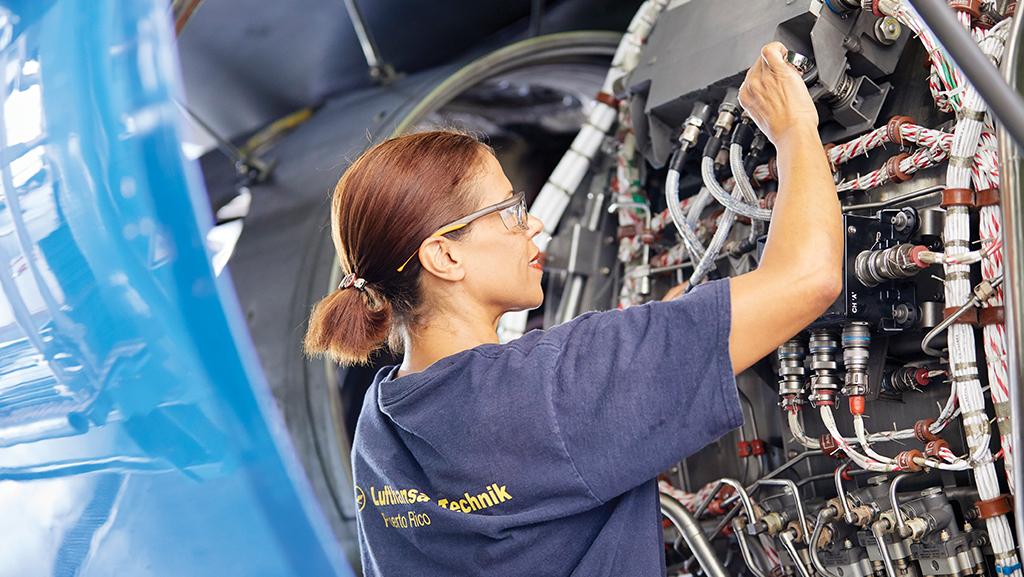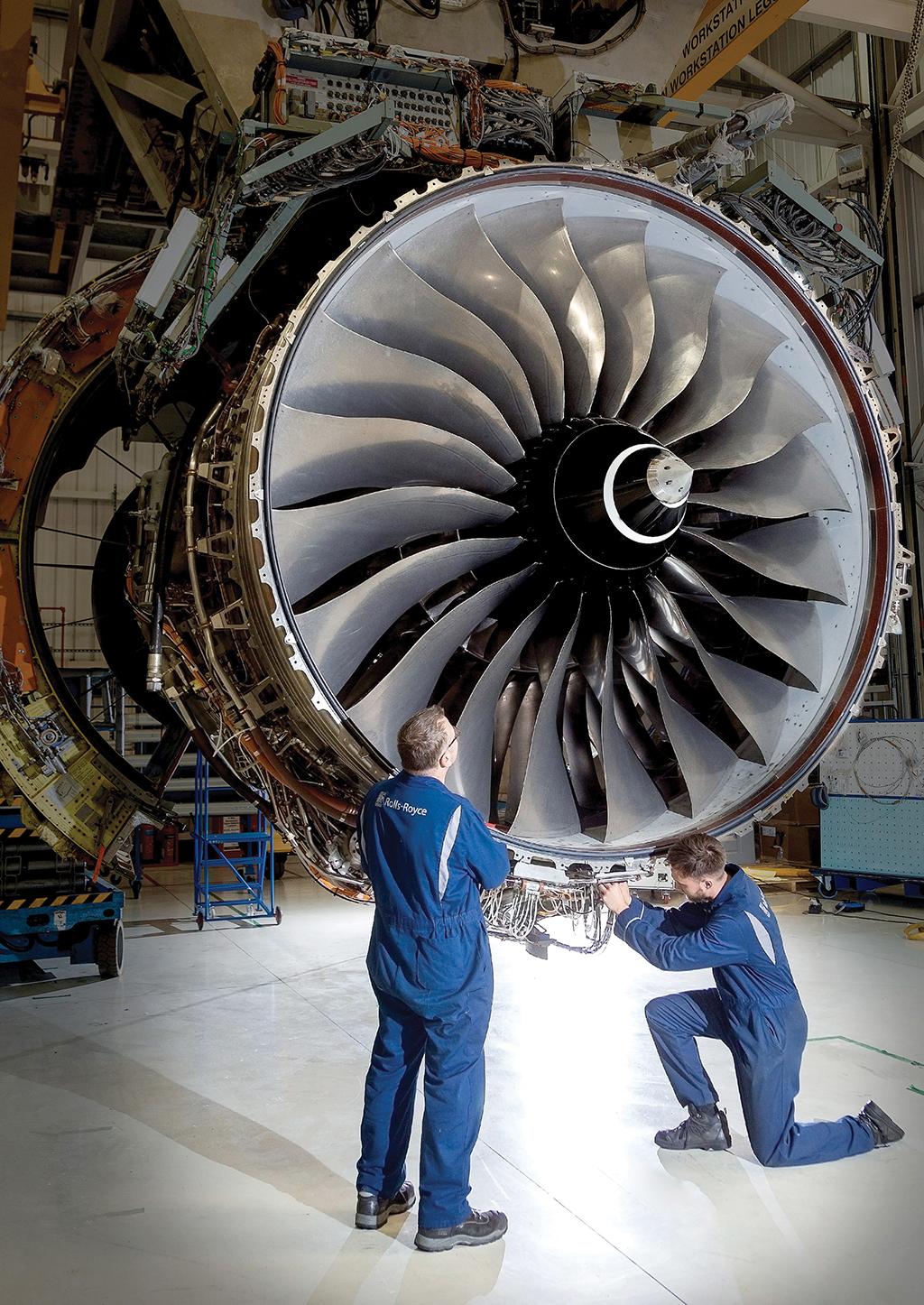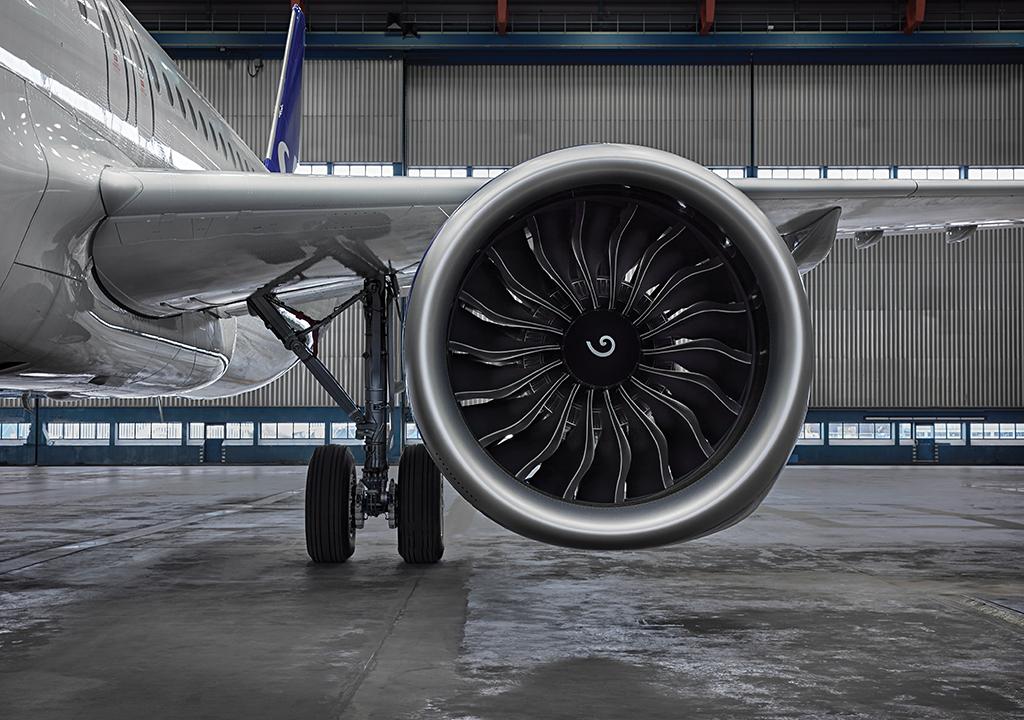
Inflation is affecting pricing of engine materials and parts, as well as factors such as logistics and workforce recruitment.
After a two-year slump tied to the significant reduction in flying caused by the passenger-demand downturn, engine maintenance activity is slowly trending upward—particularly for heavier workscopes. But an across-the-board return to pre-pandemic levels is still seen as a few years off, with engine shop-visit activity not expected to hit 2019 levels until 2024 or later.
Considering the passenger recovery’s trajectory—domestic and intra-regional flying trending upward more quickly than long-haul passenger flying—it should come as no surprise that narrowbody engines are driving most of the activity so far in 2022. Still, MRO activity in the segment falls well short of pre-crisis levels. As expected, it is CFM Inter-national CFM56 and International Aero Engines V2500 engine shop demand providing much of the heavy lifting (see table, p. MRO16). The downturn has pushed the inevitable spike in shop visits for the newest narrowbody workhorses, the CFM Leap and Pratt & Whitney PW1000G families, out a few years until closer to the end of the decade.
CFM joint-venture partner Safran sees Leap shop visits rising from about 500 in 2025 to around 2,000 in 2030. By then, the newest CFM motor will be splitting the CFM fleet’s projected 4,000 annual shop visits—a figure that underscores how much life the CFM56 family still has in it.

V2500 shop visits are bouncing back as well, in part because the family’s utilization is rising. V2500 cycles in August totaled 73% of August 2019, a tick behind the CFM56’s 77%, Aviation Week Network Tracked Aircraft Utilization (TAU) data show. After totaling about 600 in 2021, V2500 shop visits are projected to reach 700 this year and climb to a peak of 850-1,000 annually around mid-decade. Executives with Pratt parent Raytheon Technologies are projecting peak annual totals closer to the range’s lower end, “taking into account the higher retirements that we’re expecting,” Chief Financial Officer Neil Mitchill said on a mid-year earnings call. “If it’s higher, that will be great news,” he added. Lower activity in China due to a series of COVID-19-related lockdowns is also suppressing demand for overhauls, particularly in the heavily used Western narrowbody fleets.
PW1000G shop visits are projected to begin their significant ramp-up around 2027.
The sluggish widebody engine market, by no means buoyant in terms of maintenance activity, is seeing some signs of recovery in regions such as North America, Europe and more recently, the Asia-Pacific, where airlines are starting to reactivate their larger aircraft. This is further bolstered by the ongoing spike in widebody cargo aircraft utilization, with legacy engines such as the GE CF6 and Pratt PW4000 providing steady maintenance workflows and very low retirement rates—a sign of how valuable these engines are to freight operators.
A good illustration of the slow-moving uptick in the widebody segment is through mid-year OEM financial reports. In August, Rolls-Royce reported that shop visits for engines tied to long-term service agreements stood at approximately 321 in the first half of 2022, with the figure accounting for major overhauls or restorations and minor workscopes. This figure was slightly down from the 326 undertaken in the same period in 2021.
Nevertheless, the British engine-maker has predicted a maintenance demand surge in the second part of the year, due in part to increased Trent flying activity.
TAU showed that the Trent fleet’s August 2022 cycles were 72% of comparable August 2019 figures and were rising sharply. This occurred despite a decline in the total number of active Trent engines. The General Electric CF6 and GE90 families were even closer to pre-pandemic activity, each at 83%. The Pratt PW4000 fleet was at 63%. Like the Trent, each family has fewer engines in service today than three years ago.
Like other OEMs, Rolls will likely look to third parties to help meet any ramp-ups. Rolls saw 477 total shop visits in the first half of the year, including both heavy overhauls and lighter workscopes, and recently reaffirmed its full-year target of 1,100-1,200, or 15-20% above last year’s total of 953.
Its shop-visit mix is also changing as widebody flying continues to recover. Last year, 22% of Rolls shop visits were for large-engine overhauls and refurbishments, while 42% were for lighter large-engine workscopes. The refurbishment percentage is expected to grow over the medium term, driven in part by Trent XWB-84 initial shop visits, the company said in an early-September investor update. Some 80% of the 720 XWB-84s in service have not reached their first major overhaul. The Aviation Week Fleet Discovery database shows 992 XWB-84s in the global fleet, including about 60 that are parked or stored. The engines power Airbus A350s.
Fellow engine manufacturer GE Aviation stated this summer that it would look to feed some services through to third-party MRO providers, while Safran has moved to do the same thing, turning to ST Engineering to perform quick-turn engine services on CFM56 engines coming back online.
The penchant for quick-turn services has been among the key developments in the engine services segment over the past 2.5 years. With some cash-conscious airlines still unwilling to finance full restorations, MROs have had to adapt to meet the changing market dynamics. Some engine maintenance specialists that grew their quick-turn and hospital shop visit capabilities during the pandemic expect demand for these services to continue over the next few years.
Inflation costs and rising interest rates are starting to seep through to the engine aftermarket, although a greater impact is expected from 2023, should rates continue to rise.
“We’re looking at pricing,” Raytheon CEO Greg Hayes said at an early-September Morgan Stanley investor conference. “We put out a catalog price increase early this year that will take effect [in October]. And that price increase is healthy because it recognizes the fact that costs are going up. That is the one lever that we have, and it’s not popular with the airlines, but they have seen price increases, and they’re going to see price increases in their supply chain as well.”
Inflation and rising interest rates affect not just the pricing of materials and parts but also other factors such as logistics costs, with some airlines reporting long-haul engine transportation costs increasing four-fold, as well as energy prices—an issue particularly affecting Europe, as it struggles to find alternative energy supplies to Russia.
Rising inflation could become increasingly problematic in areas such as recruitment, according to Derrick Siebert, vice president of commercials, engine services at Lufthansa Technik.
“Inflation is further amplifying the problems we already had around recruitment,” he said at Aviation Week’s Aero-Engines Europe conference in Dublin in September. “There is an expectation of more attractive salaries and incentives, and amplified inflation makes all of this much more costly and difficult to grow the workforce and be attractive.”
Cost increases could also seep into other pillars of the engine aftermarket, including lessors, with concerns that rising compensation and maintenance rates will eventually have an impact on the leasing segment. James McLoughlin, vice president of powerplants at Irish lessor Vmo Aircraft Leasing, tells Aviation Week that many lease contracts are negotiated on specific escalation numbers, estimated at 3-4%. He adds that increased price escalation could mean that these percentages could eventually be higher at the end-of-lease stage and lead to increased maintenance exposure for lessors if they do not have an end-of-lease true-up mechanism.
Other lessors anticipate that price escalation could mean OEMs passing on the increased costs to their customers for new engine model assets with likely increases for used serviceable materials (USM), should inflation continue to rise.

A primary concern for the market is being prepared for the upturn in shop visits. Constrained capacity has been problematic for some time after OEMs cut production rates and certain suppliers slashed their workforces, resulting in supply chain bottlenecks. From a capacity standpoint, service divisions of engine OEMs as well as engine MRO specialists have moved to plan for the long term by announcing plans to either grow capacity at existing sites or build additional facilities.
In the near term, there are more pressing challenges. Among these are that airlines are finding it difficult to secure limited maintenance slots. Adding to that is that even when an engine goes in for a shop visit, turnaround times (TAT) are also proving to be longer than they were pre-pandemic. While some improvements have been noted this year on the 60-90-day time periods cited at the height of supply chain constraints last year, TATs are still markedly longer than before the pandemic.
Carriers are seeing this across the global regions, including Europe, where Scandinavian Airlines’ (SAS) Praveeni Witharana Nelson, senior engineer for powerplant engineering-tech ops CAMO engineering, recently noted this trend as contributing to increased TATs, specifically for newer Leap engines. “We see a lot of TAT issues because with Leap engines, the average is about 212 days for us over the past years, which far exceeds the average,” she said at the Aero-Engines Europe conference. The lack of manpower is contributing to this not just in terms of TAT but also other areas. “We find out about quality issues at the end of the shop visit rather than during the initial inspections, and these may have been missed through a lack of skilled labor,” Witharana Nelson explains.
To help carry out future ramp-ups, the engine segment will need enough qualified staff to meet demand. Attracting skilled labor into the commercial aftermarket has always been challenging, but the so-called great resignation from the industry, a movement that has seen swathes of skilled labor exit the aviation workforce over the past 2.5 years, is expected to have lingering consequences.
Specifically in the engine aftermarket, labor shortages are a primary driver of some of the main challenges faced such as longer TATs, material deficiencies and supply chain bottlenecks. “A lot of shops are not ready for this busier environment because a lot of people left, and now these MRO providers are trying to employ new people,” says Francesco Baccarani, program manager for engines at SGI Aviation.
A recruitment drive from the industry is expected, although the challenge will lie in finding sufficiently skilled people in the required volume and in the right location. While before the pandemic it was easier to characterize labor trends by region, this is now even more fragmented depending on the specific country. Alexandre Soares Garrinhas, fleet contracts manager at TAP Air Portugal says in the airline’s home base of Portugal it is experiencing recruitment challenges after stepping up efforts to bring in new people this year following cuts during the pandemic.
“There’s the wages gap, so it’s difficult for us as a country and a company to compete with the other players in the industry,” Garrinhas says. He remains unsure how long this will continue, given the airline’s financial state. “We are in a restructuring plan that will last until 2025 so we’re kind of strict in what kind of measures we can take,” he adds.
As airlines increase flying and bring their engines back into service, an increase in USM requirements is being noted by engine specialists in the industry. Unsurprisingly, green-time engine asset demand remains strong as airlines forgo expensive overhauls for as long as possible. This has led to a spike in demand for certain asset types, with price comparisons for some assets resembling 2019 figures.
Pre-COVID in 2019, the expectation across the industry was that retirements would slow down. But since 2020 and with the outbreak of the pandemic leading to mass groundings of the global aircraft fleet, the industry has speculated about if, and exactly when, the so-called “retirement bow wave” will occur.
So far retirements have remained subdued in 2022, with factors such as newer-production aircraft coming on stream, rising interest rates and the high cost of capital cited by the industry as reasons why a retirement spike may not occur in the near to midterm. As a result, the lack of teardowns has reduced USM supply to the market. “Retirement rates have definitely been a lot lower than we anticipated, and we expected a lot more aircraft to have been disassembled by now,” Lee Carey, vice president for asset management at EirTrade, said during a discussion on USM and retirement outlooks at Aero-Engines Europe.

Even if this supply eventually picks up, capacity could again have an impact. “We have to take into consideration the shop capacity for teardowns and piece-part repairs responders, where there will be challenges,” said fellow panelist Rudiger Heinrich-De Stefano, director of material management at MTU Maintenance. “What needs to be considered is that a technically repairable part does not always mean it can be sold easily to the market just because the market is demanding those parts that are scrapping out of the engines. Even for those that may need more of these parts, they’re also scrapping them out of the engines that are going to retirement.”
The green-time phenomenon was expected to be linked directly to demand—airlines keeping aircraft idle because travel trends did not justify flying them. But other factors are also playing a role in keeping aircraft on the ground at some airlines.
A gap between available pilots and demand for lift is prolonging the window in which some airlines can tap available engines on parked aircraft to push off engine overhauls, AAR President and CEO John Holmes says.
“The green-time [usage window] is lasting longer than we would have anticipated,” Holmes told analysts on a mid-September earnings call. “And the pilot shortage is definitely contributing to that, in as much as you’ve got a number of aircraft that are on the ground because airlines don’t have pilots.”
One of AAR’s “large customers” has 50 aircraft on the ground “as a result of pilot shortages,” he continued. “That’s 100 engines that they now have access to, to swap around and burn off green time. So that’s definitely persisting longer than we would have imagined.”
Green-time engines can come from several sources, including parked aircraft or ones that are idled but not yet in long-term storage. Aviation Week Fleet Discovery shows 2,311 commercial aircraft classified as parked—meaning they are idled but not in long-term storage. North American operators have 588 parked, or 25% of the total fleet. Among the four largest U.S. carriers, United Airlines has the most parked aircraft, at 62.
Holmes did not identify any customers or regions contributing to the delayed engine overhaul trend AAR is seeing. Most of the company’s heavy maintenance work is for North American customers.
Engine overhauls that AAR expected to have occurred are being delayed because aircraft are on the ground, Holmes said, adding that a lack of pilots is just one of several reasons. “That’s pushing that inflection point out,” he added.
The green-time usage trend is delaying some engine part-outs, which is a headwind for the used materials market.
“We continue to see broadening interest in USM, but the immediate demand for used parts continues to be impacted by the utilization of green time as well as the lack of material availability for certain high-demand assets,” Holmes said.
One silver lining to having a tight USM market: “Our new- parts distribution activities continue to deliver meaningful growth,” he said.




